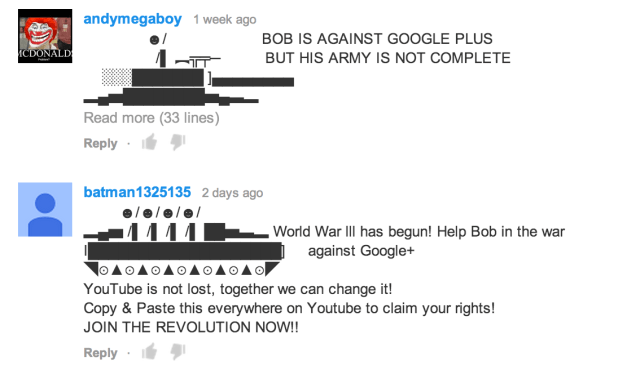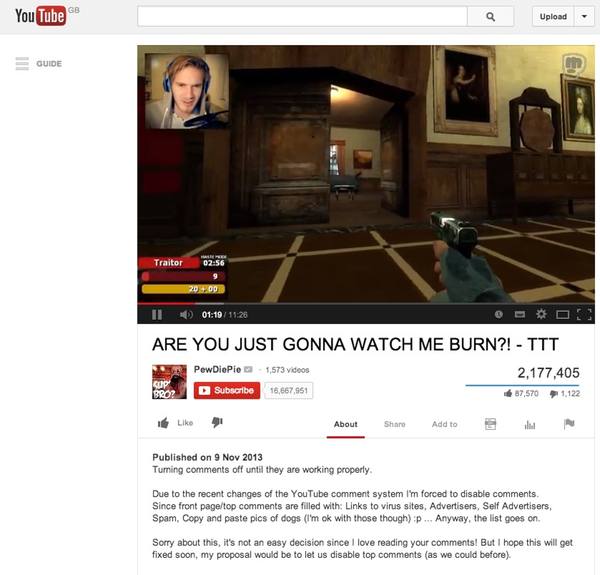Google says it’s taking steps to address the increase in YouTube comment spam that arose from the recent shift to the new commenting system powered by Google+. YouTube users have already been fairly displeased with the new system for reasons related to privacy, confusion, and the ability to leave anonymous comments, having already left over 31,000 comments of their own on a video post announcing the changes, many negative. In addition, the most popular petition begging Google to reconsider a move back to the old system has over 215,000 signatures today.
Google+, which is both a destination website and social layer meant to stretch across all Google-owned properties, has been seeping into everything Google puts out, including Search, Gmail, Calendar, Drive, Blogger, and more. It has also sucked up properties like Picasa and Places, which are now Google+ Photos and Google+ business pages, respectively, into the Google+ identity machine.
But YouTube, Google’s already successful and profitable social networking site, is another matter. Here, users had long established identities of a sort – ones they don’t necessarily want linked to their real names, and ones where they’ve connected with and messaged other YouTube users over the years.
On the YouTube video detailing the change to Google+ comments, there’s an overlay reading: “Thanks for your feedback. We know there are issues with spam and abuse in the new system and we’re working hard to fix them. Click here to learn more.” That link has been directing viewers to a November 6 post on the official YouTube Creators blog, which was updated mid-November with a further acknowledgement of the spam and abuse problems and a promise that fixes were in the works.
It was close as Google got to an admission of failure in terms of its implementation of Google+ comments on YouTube. It’s clear the company didn’t think through the ramifications of a system which would allow Google+ users to include links or other random text in their YouTube comments.
For instance, some commenters are now using ASCII text to leave picture comments, which isn’t abusive as much as it is disruptive – it’s probably not the “high quality” feedback Google had in mind when making this change.

As security researcher Graham Cluley explains today, YouTube may have been home to “some of the most unpleasant, purile and single-braincelled comments in the universe” but it never before had a problem with link spam, because the older commenting system prevented users from leaving messages which included clickable links. But that changed when Google+ comments arrived.
Google had positioned the change as one which would lead to better feedback for publishers since it was doing away with the negativity that inevitability arises when anonymous commenting is supported. (Google+ users have to set up accounts using their “real name,” which should have cut down on the abuse.) But better comments were not the result, as it turned out.
Google quickly realized that the system was not as well-guarded against those who would leverage the link-posting capability for less than reputable purposes. Spammers, scammers and those posting malware in link format took advantage of the new system. In his post, Cluley notes that there was so much abuse that some YouTube publishers, including video games reviewer PewDiePie for example, disabled Google+ comments completely after the front pages of its comments sections on videos were filled with links to viruses and spam.

Part of the problem with the abuse is that Google+ favors those whose comments get the most replies. Since many on the web don’t know the ol’ web adage “don’t feed the trolls,” spamming and abusive comments would rise to the top as other angry commenters responded.
On Monday, Google finally issued a progress report on the efforts it has made at addressing the spam and abuse. Again on the YouTube Creators blog, the company announced that the video site has now made a number of changes to combat the increase in spammy comments. These include: “better recognition of bad links and impersonation attempts”; “improved ASCII art detection”; and “changing how long comments are displayed,” the post explains.
“We know the spam issues made it hard to use the new system at first, and we’re excited to see more of you getting involved as we’ve fixed issues,” reads the post signed by the “YouTube Comments Team.”
The company also promised other changes were in the works, too, such as threaded conversations, formatted comments, and the much-requested option of bulk moderation. And the comments team added also that it’s still working on “improving comment ranking,” which will continue to be necessary as scammers try to find workarounds to the new system and get their comments moved up to the top yet again.
[Image credits: YouTube, GrahamCluley/PewDiePie]
